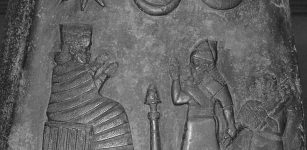Pants And Boots Were Forbidden In Ancient Rome – Trousers Were A Symbol Of Barbarism To Ancient Romans
Conny Waters - AncientPages.com - If you lived in ancient Rome, you would think twice before putting on your pants.
To ancient Romans, trousers were the ultimate symbol of barbarism, and no honorable man wanted to be considered the garb of a savage barbarian.
Credit: Costumes of All Nations (1882) by Albert Kretschmer - Public Domain
There was even a law that strictly prohibited wearing pants and boots in ancient Rome.
Pants and boots (called in Latin 'bracae') were associated with horse-riding barbarians, including many Germanic groups such as Goths, Huns, Vikings, and others.
The term "Barbarians" is today significantly misused. The original meaning of the word "barbarian" did not refer to acts of evil but rather to those who were not Greek or did not speak Greek. In modern times we often say Barbarians are uncivilized people or evil people.
When Ovid, a Roman poet who lived during Augustus's reign, encountered barbarians in today's Tomis, Romania, he wrote:
"The people, even when they were not dangerous, were odious, clothed in skins and trousers with only their faces visible."
One law from 397 and another dated to 399 CE strictly regulated wearing pants and boots in Rome.
Within the city of Rome, no one shall wear pants or boots. But if any man after the issuance of this regulation of Our Clemency should obstinately persist in such contumacy, he shall be punished accordingly as his legal status permits and expelled from our sacred city (Codex Theodosianus, 14.10.3 (June 6, 399 CE)
Gaulish chief Vercingetorix, wearing trousers, surrenders to Julius Caesar after the battle of Alesia in 52 B.C. Painting by Lionel Royer (1852–1926) - Credit: Public Domain
According to Susanne Elm, a historian from the University of California, Berkeley, who studies Rome's relationship with the tribes to the north, "barbarian influence on fashion was something that emperors wanted to control, but then their bodyguards, which presumably they trusted, were barbarians."
The ban on trousers and boots was a desperate attempt to keep the Roman identity alive. During this period, the Empire had become a melting pot of traditions after hundreds of years of expansion and cultural appropriation. Long hair and flashy jewels soon joined boots and pants as forbidden fashion.
"By the fifth and sixth centuries, suddenly the so-called barbarian custom, sleeved top, and trousers had become the official uniform of the Roman court. If you were close to the emperor, that's what you would wear." Professor Kelly Olson, the author of "Masculinity and Dress in Roman Antiquity," said. "Scholars have not yet been able to explain how that happened, trousers going from being banned from being legally required clothes for the Roman court."
It could be explained by the fact that ancient Romans, who were totally against trousers and boots, changed their attitude when Roman soldiers marched into cold Northern Europe and realized the benefits of wearing warm clothes and shoes.
Written by Conny Waters – AncientPages.com Staff Writer
Updated on October 29, 2022
Copyright © AncientPages.com All rights reserved. This material may not be published, broadcast, rewritten or redistributed in whole or part without the express written permission of AncientPages.com
Expand for references
More From Ancient Pages
-
 Why Has The Leaning Tower Of Pisa Survived Strong Earthquakes Since The Middle Ages?
Archaeology | May 10, 2018
Why Has The Leaning Tower Of Pisa Survived Strong Earthquakes Since The Middle Ages?
Archaeology | May 10, 2018 -
 Something Never-Before-Seen Is Hidden Beneath 15 Giant Viking Burial Mounds Spotted By Radar In Norway
Archaeology | Jan 19, 2021
Something Never-Before-Seen Is Hidden Beneath 15 Giant Viking Burial Mounds Spotted By Radar In Norway
Archaeology | Jan 19, 2021 -
 Ancient Urartu Settlement, Water Tunnel And Rock Tombs Found In Erzurum, Eastern Turkey
Archaeology | Dec 19, 2017
Ancient Urartu Settlement, Water Tunnel And Rock Tombs Found In Erzurum, Eastern Turkey
Archaeology | Dec 19, 2017 -
 Mystery Of The Amazing 2,500-Year-Old Underwater Rochelongue Treasure
Featured Stories | Jul 7, 2023
Mystery Of The Amazing 2,500-Year-Old Underwater Rochelongue Treasure
Featured Stories | Jul 7, 2023 -
 Unique Steelyard Discovery Sheds Light On Life At Milecastle 46
Archaeology | Aug 4, 2023
Unique Steelyard Discovery Sheds Light On Life At Milecastle 46
Archaeology | Aug 4, 2023 -
 Dwarka – Pre-Harappan City That Could Rewrite The History Of The World
Civilizations | Aug 19, 2014
Dwarka – Pre-Harappan City That Could Rewrite The History Of The World
Civilizations | Aug 19, 2014 -
 Mycenae Kingdom: Home To King Agamemnon And Tholos Tomb ‘Treasure of Atreus’
Civilizations | Jun 11, 2022
Mycenae Kingdom: Home To King Agamemnon And Tholos Tomb ‘Treasure of Atreus’
Civilizations | Jun 11, 2022 -
 Unique Early Alemannic Chamber Grave Discovered In Gerstetten, Germany
Archaeology | Sep 20, 2024
Unique Early Alemannic Chamber Grave Discovered In Gerstetten, Germany
Archaeology | Sep 20, 2024 -
 On This Day In History: Practical Underwater Diving Suit Patented By Maine Inventor – On June 14, 1834
News | Jun 14, 2016
On This Day In History: Practical Underwater Diving Suit Patented By Maine Inventor – On June 14, 1834
News | Jun 14, 2016 -
 On This Day In History: Supernova Observed In The Constellation Cassiopeia Was Recorded – On August 4, 1181
News | Aug 4, 2016
On This Day In History: Supernova Observed In The Constellation Cassiopeia Was Recorded – On August 4, 1181
News | Aug 4, 2016 -
 What Was An Aztec Confession?
Ancient History Facts | Jul 25, 2017
What Was An Aztec Confession?
Ancient History Facts | Jul 25, 2017 -
 Vai Script – Rare African Manuscript Offers Clues Into How Writing Evolved
Archaeology | Jan 11, 2022
Vai Script – Rare African Manuscript Offers Clues Into How Writing Evolved
Archaeology | Jan 11, 2022 -
 Kudurru Of Melishihu – Stone Records From The Kassite Dynasty In Babylonia
Artifacts | Jan 17, 2016
Kudurru Of Melishihu – Stone Records From The Kassite Dynasty In Babylonia
Artifacts | Jan 17, 2016 -
 Archaeological Evidence Of Human Presence In America 250,000 Years Ago?
Featured Stories | Mar 5, 2024
Archaeological Evidence Of Human Presence In America 250,000 Years Ago?
Featured Stories | Mar 5, 2024 -
 Mysterious Mongolian Arc Investigated By Scientists
Archaeology | Jan 2, 2024
Mysterious Mongolian Arc Investigated By Scientists
Archaeology | Jan 2, 2024 -
 ‘Little Foot’ Is An Entirely New Species Of Early Human – Researchers Say
Archaeology | Jan 3, 2019
‘Little Foot’ Is An Entirely New Species Of Early Human – Researchers Say
Archaeology | Jan 3, 2019 -
 Finds At Timna Valley Date Back To King Solomon-Era And Point To Sophisticated Ancient Society
Archaeology | Mar 3, 2017
Finds At Timna Valley Date Back To King Solomon-Era And Point To Sophisticated Ancient Society
Archaeology | Mar 3, 2017 -
 Pitted Ware Culture – Neolithic Scandinavians Used Skin Boats To Trade And Travel Across Large Distances
Archaeology | Sep 11, 2024
Pitted Ware Culture – Neolithic Scandinavians Used Skin Boats To Trade And Travel Across Large Distances
Archaeology | Sep 11, 2024 -
 Neolithic Culinary Traditions Uncovered
Archaeology | Sep 7, 2022
Neolithic Culinary Traditions Uncovered
Archaeology | Sep 7, 2022 -
 Unexplained Accounts Of Mysterious Fires – ‘Burning’ Questions Remain Unanswered – Part 1
Featured Stories | Aug 2, 2019
Unexplained Accounts Of Mysterious Fires – ‘Burning’ Questions Remain Unanswered – Part 1
Featured Stories | Aug 2, 2019


